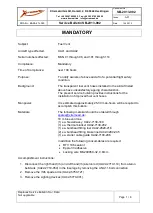
GRUMMAN AMERICAN
FOR TRAINING USE ONLY – SECTION 3
MODEL GA-7/COUGAR
EMERGENCY PROCEDURES
3-24
Issued: April 10, 1978
ONE ENGINE INOPERATIVE OPERATION
ONE ENGINE INOPERATIVE APPROACH
In addition to normal approach considerations, other factors must be considered in a one engine approach.
Included are reduced power and control capabilities, adverse effects of adding and reducing power, and the fact
that level flight may not be possible for certain combinations of weight, temperature, and altitude. Any decision to
go around must be made early.
Set the fuel selector of the operating engine to the fullest tank and turn on the auxiliary fuel pump for the selected
tank. Set the carburetor heat and mixture control as required, and move the propeller control full forward.
Approach at 90 KIAS and put the landing gear down only when within gliding distance of the intended touchdown
point. When landing is assured, put the flaps full down.
ONE ENGINE INOPERATIVE GO-AROUND
WARNING
LEVEL FLIGHT MIGHT NOT BE POSSIBLE FOR CERTAIN COMBINATIONS OF
WEIGHT, TEMPERATURE, AND ALTITUDE.
When the decision is made to go around, move the propeller and throttle controls full forward, compensating for
changes in control forces and altitude. Set the mixture control as required for best power. Raise the flaps, retract
the landing gear, and open the cowl flap. Maintain 85 KIAS.
ENGINE RESTARTS IN FLIGHT (AFTER FEATHERING)
Move the fuel selector of the inoperative engine to the desired tank and turn the auxiliary fuel pump ON. Open
the throttle about one-half inch. At altitudes below 5000 feet, set the mixture control at full rich. At high
altitudes, match the lever position with that of the operating engine. Turn both Magneto Switches of the
inoperative engine ON.
Set the propeller control at the HIGH RPM (low pitch) position. In airplanes with unfeathering accumulators
installed, the propeller will unfeather and begin to windmill at airspeeds above 95 KIAS. Use the starter as an aid
in unfeathering if necessary.
In airplanes not having unfeathering accumulators, use the starter to unfeather the propeller. When the engine
starts, adjust throttle, mixture, and propeller controls to maintain operation. If the engine turns over but fails to
start, try different combinations of prime, throttle position, and mixture position until engine starts and
accelerates to normal idle.
When a normal idle is obtained, turn the auxiliary fuel pump OFF and the alternator ON. Check the oil pressure.
Warm the engine up at 2000 RPM and 15 MP. When engine is warmed up, set power and trim as required.
Continued flight with an unreliable engine is inadvisable. Land at the nearest suitable airport and determine the
cause for engine failure.
















































